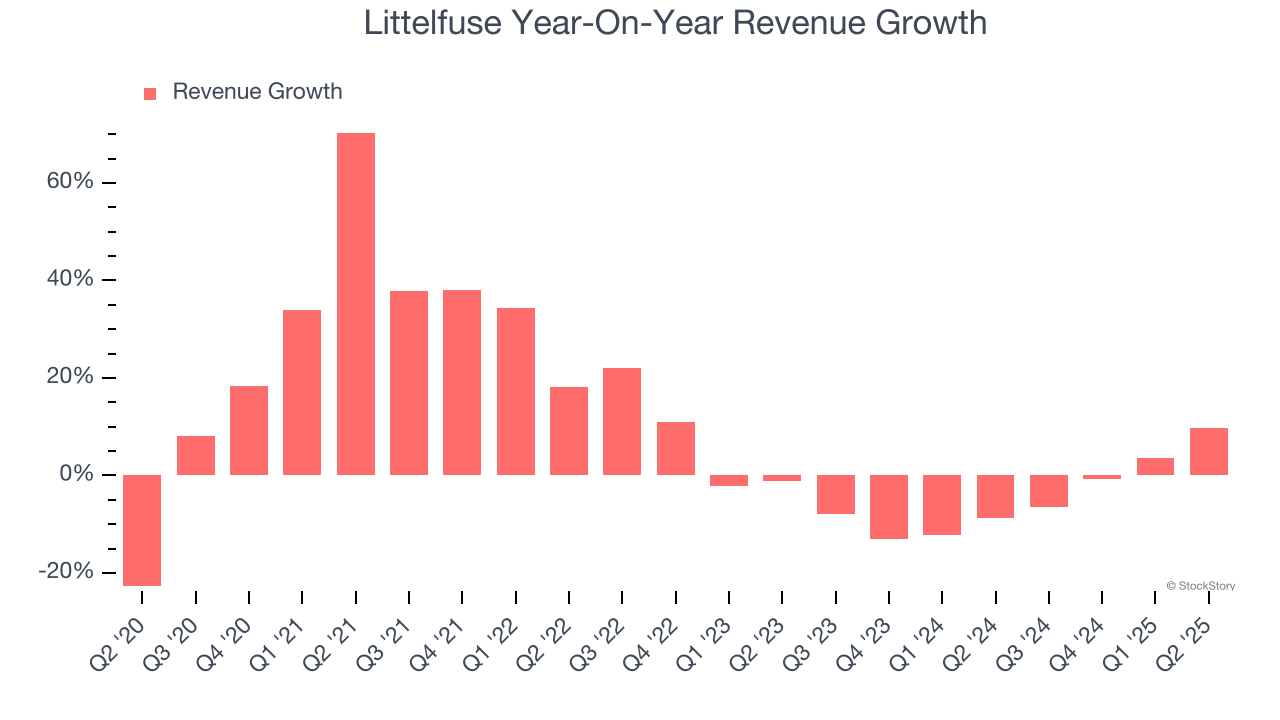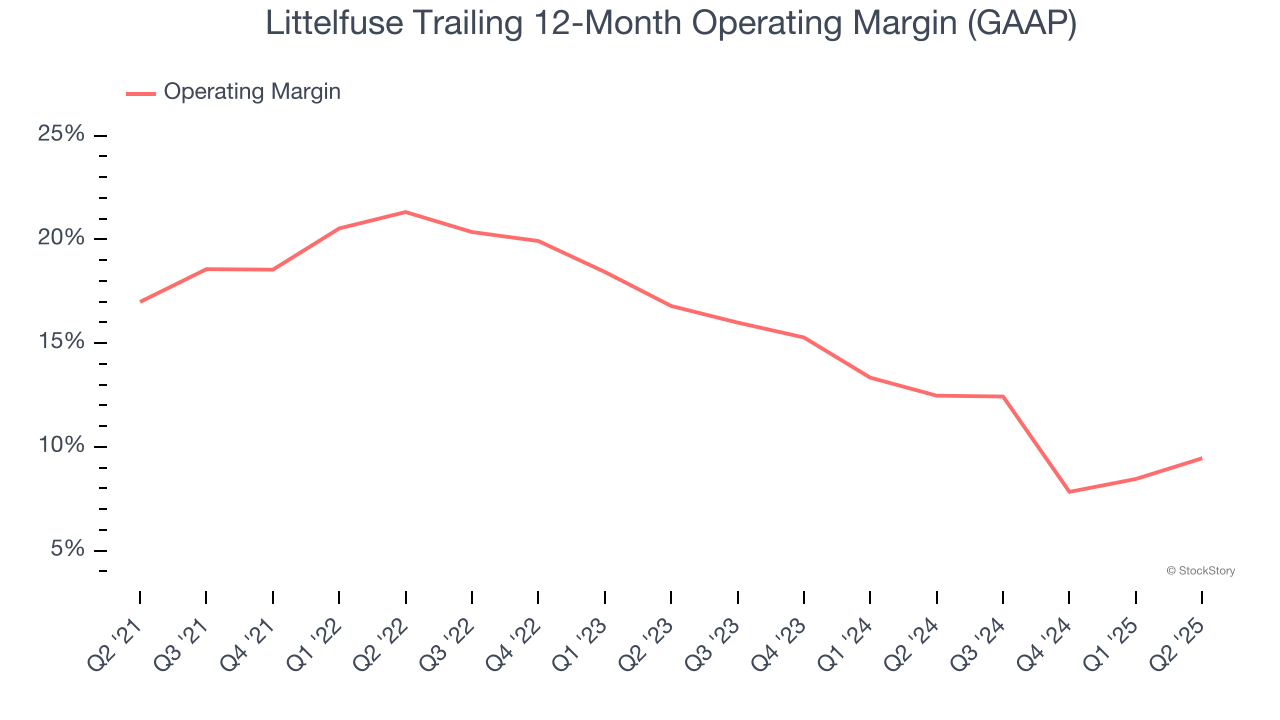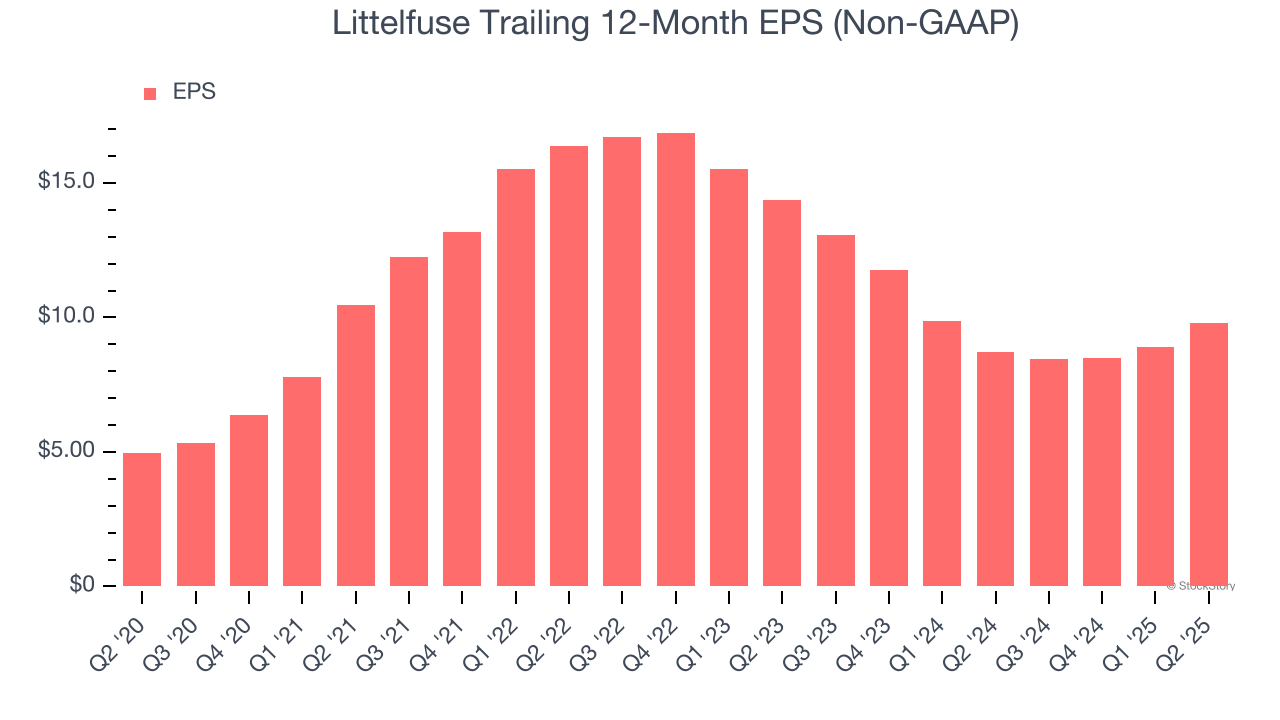
Electronic component provider Littelfuse (NASDAQ: LFUS) reported Q2 CY2025 results beating Wall Street’s revenue expectations, with sales up 9.8% year on year to $613.4 million. On top of that, next quarter’s revenue guidance ($620 million at the midpoint) was surprisingly good and 6.7% above what analysts were expecting. Its non-GAAP profit of $2.85 per share was 22.2% above analysts’ consensus estimates.
Is now the time to buy Littelfuse? Find out by accessing our full research report, it’s free.
Littelfuse (LFUS) Q2 CY2025 Highlights:
- Revenue: $613.4 million vs analyst estimates of $574.3 million (9.8% year-on-year growth, 6.8% beat)
- Adjusted EPS: $2.85 vs analyst estimates of $2.33 (22.2% beat)
- Adjusted EBITDA: $131.1 million vs analyst estimates of $111 million (21.4% margin, 18.1% beat)
- Revenue Guidance for Q3 CY2025 is $620 million at the midpoint, above analyst estimates of $581.2 million
- Adjusted EPS guidance for Q3 CY2025 is $2.75 at the midpoint, above analyst estimates of $2.49
- Operating Margin: 15.1%, up from 11.7% in the same quarter last year
- Free Cash Flow Margin: 0%, down from 9% in the same quarter last year
- Market Capitalization: $5.83 billion
“Our Q2 results exceeded our expectations, driven by solid growth and operational execution across our businesses,” said Greg Henderson, Littelfuse President and Chief Executive Officer.
Company Overview
The developer of the first blade-type automotive fuse, Littelfuse (NASDAQ: LFUS) provides electrical protection and control components for the automotive, industrial, electronics, and telecommunications industries.
Revenue Growth
A company’s long-term performance is an indicator of its overall quality. Any business can have short-term success, but a top-tier one grows for years. Over the last five years, Littelfuse grew its sales at an impressive 10.8% compounded annual growth rate. Its growth beat the average industrials company and shows its offerings resonate with customers.

We at StockStory place the most emphasis on long-term growth, but within industrials, a half-decade historical view may miss cycles, industry trends, or a company capitalizing on catalysts such as a new contract win or a successful product line. Littelfuse’s recent performance marks a sharp pivot from its five-year trend as its revenue has shown annualized declines of 4.7% over the last two years. Littelfuse isn’t alone in its struggles as the Electronic Components industry experienced a cyclical downturn, with many similar businesses observing lower sales at this time. 
Littelfuse also breaks out the revenue for its most important segments, Electronics and Automotive, which are 54.7% and 29.2% of revenue. Over the last two years, Littelfuse’s Electronics revenue (fuses and switches) averaged 8.1% year-on-year declines while its Automotive revenue (trucks, commercial machinery, marine) was flat.
This quarter, Littelfuse reported year-on-year revenue growth of 9.8%, and its $613.4 million of revenue exceeded Wall Street’s estimates by 6.8%. Company management is currently guiding for a 9.3% year-on-year increase in sales next quarter.
Looking further ahead, sell-side analysts expect revenue to grow 4.2% over the next 12 months. While this projection indicates its newer products and services will fuel better top-line performance, it is still below average for the sector.
Today’s young investors won’t have read the timeless lessons in Gorilla Game: Picking Winners In High Technology because it was written more than 20 years ago when Microsoft and Apple were first establishing their supremacy. But if we apply the same principles, then enterprise software stocks leveraging their own generative AI capabilities may well be the Gorillas of the future. So, in that spirit, we are excited to present our Special Free Report on a profitable, fast-growing enterprise software stock that is already riding the automation wave and looking to catch the generative AI next.
Operating Margin
Operating margin is an important measure of profitability as it shows the portion of revenue left after accounting for all core expenses – everything from the cost of goods sold to advertising and wages. It’s also useful for comparing profitability across companies with different levels of debt and tax rates because it excludes interest and taxes.
Littelfuse has been an efficient company over the last five years. It was one of the more profitable businesses in the industrials sector, boasting an average operating margin of 15.4%. This result isn’t surprising as its high gross margin gives it a favorable starting point.
Looking at the trend in its profitability, Littelfuse’s operating margin decreased by 7.5 percentage points over the last five years. This raises questions about the company’s expense base because its revenue growth should have given it leverage on its fixed costs, resulting in better economies of scale and profitability.

In Q2, Littelfuse generated an operating margin profit margin of 15.1%, up 3.4 percentage points year on year. The increase was encouraging, and because its operating margin rose more than its gross margin, we can infer it was more efficient with expenses such as marketing, R&D, and administrative overhead.
Earnings Per Share
Revenue trends explain a company’s historical growth, but the long-term change in earnings per share (EPS) points to the profitability of that growth – for example, a company could inflate its sales through excessive spending on advertising and promotions.
Littelfuse’s EPS grew at a remarkable 14.6% compounded annual growth rate over the last five years, higher than its 10.8% annualized revenue growth. This tells us the company became more profitable on a per-share basis as it expanded.

Like with revenue, we analyze EPS over a more recent period because it can provide insight into an emerging theme or development for the business.
For Littelfuse, its two-year annual EPS declines of 17.5% mark a reversal from its (seemingly) healthy five-year trend. We hope Littelfuse can return to earnings growth in the future.
In Q2, Littelfuse reported EPS at $2.85, up from $1.97 in the same quarter last year. This print easily cleared analysts’ estimates, and shareholders should be content with the results. Over the next 12 months, Wall Street expects Littelfuse’s full-year EPS of $9.79 to grow 6.7%.
Key Takeaways from Littelfuse’s Q2 Results
We were impressed by Littelfuse’s optimistic revenue and EPS guidance for next quarter, which blew past analysts’ expectations. We were also excited its revenue, EPS, and EBITDA outperformed Wall Street’s estimates by a wide margin. Zooming out, we think this was a good print with some key areas of upside. The stock traded up 7.2% to $252.79 immediately after reporting.
Indeed, Littelfuse had a rock-solid quarterly earnings result, but is this stock a good investment here? The latest quarter does matter, but not nearly as much as longer-term fundamentals and valuation, when deciding if the stock is a buy. We cover that in our actionable full research report which you can read here, it’s free.





